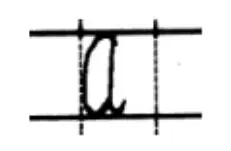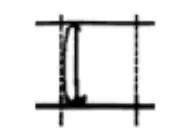Handwriting is more than just a method of communication—it’s a mirror of the writer’s inner world. Among the many traits graphologists analyze, constricted handwriting—especially in the middle zone—offers deep psychological insights. In this article, we’ll explore what constricted letter width reveals about personality, behavior, and emotional tendencies.
What Is Constricted Handwriting?
Constricted handwriting refers to letters that are noticeably narrow, particularly in the middle zone—the area that includes letters like “a”, “e”, “o”, and “m”. When the middle zone width is less than 0.5 times the height, it is considered constricted, example:

If it’s less than 0.25 times the height, it is deemed extremely constricted, example:

This narrowing can occur in any of the three zones (upper, middle, lower), but the middle zone is especially telling when it comes to social and emotional behaviors.
What the Middle Zone Represents
The middle zone of handwriting reflects how a person interacts with their everyday world—socially, emotionally, and relationally. It symbolizes personal confidence, comfort in social settings, and interpersonal assurance.
When this zone is constricted, it signals a personality that is:
- Insecure in day-to-day relationships
- Timid and self-conscious
- Avoidant of unfamiliar social situations
These individuals prefer familiar surroundings, people, and routines. They are emotionally reserved and often struggle with expressing themselves openly. Their discomfort under emotional pressure leads them to avoid spontaneous connections, and instead, they may seek safety in routines and internal defenses.
Defensive Behavior and Emotional Suppression
Constricted handwriting also reveals a tendency to be self-protective. Writers often analyze interactions from the lens of how emotionally safe or threatening a situation might be. As a result, they may come across as distant or reserved, not out of arrogance, but due to a fear of vulnerability.
They may also:
- Withhold personal views and thoughts
- Reject outside opinions
- Cling to rigid patterns of behavior for security
Their thought process becomes confined to past experiences, making it difficult to explore new emotional territories or relationships.
Extremely Constricted Writing: Signs of Deeper Inhibition
When handwriting becomes extremely constricted, it often involves retracing—redrawing or covering over strokes, such as circling an oval twice. This act symbolizes a form of psychological hiding or suppression.
These individuals are likely to:
- Be secretive or evasive
- Fear voicing true feelings due to anxiety or fear of judgment
- Have limited social engagement
- Experience emotional tension and insecurity
Extreme narrowness is an expression of someone who is easily overwhelmed by practical life demands and avoids human contact. The retraced or concealed strokes may suggest a mind burdened by inhibition, or even an intent to disguise truths—whether out of fear, shame, or self-protection.
Final Thoughts
Handwriting analysis opens a window into the psyche, and constricted handwriting is a strong indicator of inhibition, insecurity, and emotional restraint. While it doesn’t provide a complete psychological profile, it offers valuable clues about how individuals relate to themselves and others.
Understanding these traits can foster empathy and self-awareness—not just for the writer, but for those seeking to understand them better.
Handwriting analysis has helped to understand one another in a relationship and make the relationship can last. For a better relationship, try to learn handwriting analysis at KAROHS International School of Handwriting Analysis. Visit our website to see our product
https://karohs.school/product/encyclopedia-of-handwriting-analysis-vol-a-1-10/ and follow our instagram @karohs.school for more information about handwriting analysis.

